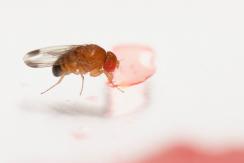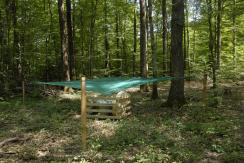Evolutionary Ecology
The department of Evolutionary Ecology gathers complementary skills in behavioural ecology, population dynamics, population biology, community ecology, and methodology (statistics and modelling). The research done in the department aims at studying how animal species evolve in a changing world by understanding the causes of the evolution of traits, adaptations and interactions. For that, we consider different levels of organization from individuals to populations and communities. Because organisms cannot be considered isolated from other biotic factors, we consider pathogens but also competing species within communities.
We study how individuals adapt to their environments that are largely impacted by anthropic pressures, and how life history traits and behaviour evolve in response to these pressures. Although we mainly focus on phenotype, we more and more consider the mechanistic link between the genotype and the phenotype. We develop the theoretical framework of our discipline through a conceptual and modeling approach. In parallel, we test hypotheses that arise from theoretical predictions through experimental, comparative and observational approaches on different biological models (insects, birds, mammals). Experimental approaches are developed in the laboratory (insect model) and in natura (bird, insect and mammal models). Observational and comparative research is mainly concerned with vertebrates. Our approaches are also, and increasingly, interested in the mechanisms of adaptive responses. In addition to the classical approaches of demographic analysis and trait change, methods of ecophysiology, chemical ecology and molecular biology are used.
Our department hosts several long-term studies of wild populations of different species. These long-term studies offer a valuable way to understand how biotic and abiotic factors affect individuals’ life history traits, and the functioning of populations in natura. Five populations of mammalian species are thus monitored for several years (more than 40 years on roe deer, 30 on Alpine marmots, 25 years on cats, 16 years on zebras, and 20 years on impala). Two of our study sites (La Sassière in Vanoise National Park (Alpine marmots) and Hwange National Park) have been certified as “Site d’Etude en Ecologie Globale” (SEEG), and two (ZA “Hwange” and ZA “Antarctic and sub-Antarctic”) were certified as “Zone Atelier” by the CNRS.
The department of Evolutionary ecology is also largely involved in training activities. Lastly, we also have strong socio-economic relationships. Indeed, because we address questions of major societal interest (global warming, public health) we tightly collaborate with socio-economic partners (Office Français de la Biodiversité, Vanoise National Park, Hwange National Park in Zimbabwe, Office National des Forêts, etc.) and participate to general public and media events.
Publications
Display of 301 to 330 publications on 2449 in total
Deleterious effects of thermal and water stresses on life history and physiology: a case study on woodlouse
Peer Community Journal . 3 : e7
Journal article
see the publicationSex differences in adult lifespan and aging rate across mammals: A test of the ‘Mother Curse hypothesis’
Mechanisms of Ageing and Development . 212 : 111799
Journal article
see the publicationIn Vivo Mercury (De)Methylation Metabolism in Cephalopods under Different p CO 2 Scenarios
Environmental Science and Technology . 57 ( 14 ) : 5761-5770
Journal article
see the publicationArtifical light at night triggers slight transcriptomic effects on melatonin signaling but not synthesis in tadpoles of two anuran species
Comparative Biochemistry and Physiology - Part A: Molecular and Integrative Physiology . 280 : 111386
Journal article
see the publicationWeevil Carbohydrate Intake Triggers Endosymbiont Proliferation: A Trade-Off between Host Benefit and Endosymbiont Burden
mBio .
Journal article
see the publicationFirst expert elicitation of knowledge on possible drivers of observed increasing human cases of Tick-Borne Encephalitis in Europe
Viruses . 15 ( 3 ) : 791
DOI: 10.3390/v15030791
Journal article
see the publicationRisk assessment of BTV incursion in Europe from Sardinia by Culicoides spp. wind dispersal
2023 SVEPM conference .
Poster
see the publicationPhylteR: Efficient Identification of Outlier Sequences in Phylogenomic Datasets
Molecular Biology and Evolution . 40 ( 11 ) : msad234
Journal article
see the publicationWeighting the transitivity of undirected weighted social networks with triadic edge dissimilarity scores
Social Networks . 73 : 1-6
Journal article
see the publicationVariable rate of ageing within species: insights from Darwin’s frogs
Biological Journal of the Linnean Society . 138 ( 1 ) : 68-74
Journal article
see the publicationTemperature synchronizes temporal variation in laying dates across European hole‐nesting passerines
Ecology . 104 ( 2 ) : e3908
DOI: 10.1002/ecy.3908
Journal article
see the publicationAge and spatio-temporal variations in food resources modulate stress-immunity relationships in three populations of wild roe deer
General and Comparative Endocrinology . 330 : 114141
Journal article
see the publicationPopulation designations in biomedical research: limitations and perspectives
HLA: Immune Response Genetics . 101 ( 1 ) : 3-15
DOI: 10.1111/tan.14852
Journal article
see the publicationAmplified cyclicality in mast seeding dynamics positively influences the dynamics of a seed consumer species
The American Naturalist . 201 ( 38-51 )
DOI: 10.1086/721905
Journal article
see the publicationQuantifying the overall effect of biotic interactions on species distributions along environmental gradients
Ecological Modelling . 483 : 110424
Journal article
see the publicationIguana insularis (Iguanidae) from the southern Lesser Antilles: An endemic lineage endangered by hybridization
Zookeys . 1086 : 137 - 161
Journal article
see the publicationProjet ParCap AuRA : quels enseignements pour les vétérinaires praticiens ?
Journée des GTV Rhône-Alpes .
Conference paper
see the publicationEfficacité des anthelminthiques chez les caprins laitiers: Où en est-on?
Portes Ouvertes de la ferme expérimentale caprine du Pradel .
Conference paper
see the publicationApport de l’écologie à l’épidémiologie en santé animale
Epidémiologie et Santé Animale . ( 80 ) : 71-83
Journal article
see the publicationDiagnostic sérologique de la fièvre Q chez les petits ruminants : faut-il et comment prendre en compte l'imperfection des tests ?
Webinaire, coanimé par l’UMT PSR « Pilotage de la Santé des Ruminants » et l’OMACAP « Observatoire des Maladies Caprines » .
Conference paper
see the publicationGeneralist nematodes dominate the nemabiome of roe deer in sympatry with sheep at a regional level
International Journal for Parasitology . 52 ( 12 ) : 751-761
Journal article
see the publicationEffects of Habitat and Competition on Niche Partitioning and Community Structure in Neotropical Ants
Frontiers in Ecology and Evolution . 10 : 863080
Journal article
see the publicationFunctionally distinct tree species support long-term productivity in extreme environments
Proceedings of the Royal Society B: Biological Sciences . 289 ( 1967 ) : 20211694
Journal article
see the publicationPlant community impact on productivity: Trait diversity or key(stone) species effects?
Ecology Letters . 25 ( 4 ) : 913-925
DOI: 10.1111/ele.13968
Journal article
see the publicationGenetic variability and population size covary positively across nine badgers (Meles meles) populations in France
Mammal Research . 67 ( 2 ) : 239-244
Journal article
see the publicationLes ongulés en interaction avec leur environnement et les parasites dans un monde hétérogène et changeant
Effects of global changes on population persistence: an integrative approach
Bird populations most exposed to climate change are less sensitive to climatic variation
Nature Communications . 13 ( 1 ) : 2112
Journal article
see the publicationPerfusion imaging in deep prostate cancer detection from mp-MRI: can we take advantage of it?
19th IEEE International Symposium on Biomedical Imaging (ISBI) . : 1-5
Conference paper
see the publication





You also, comment on this article